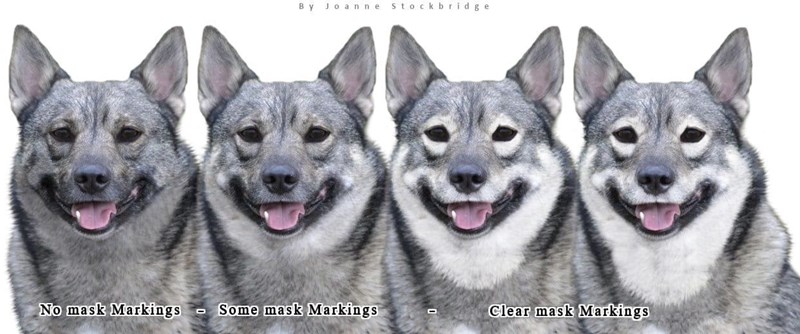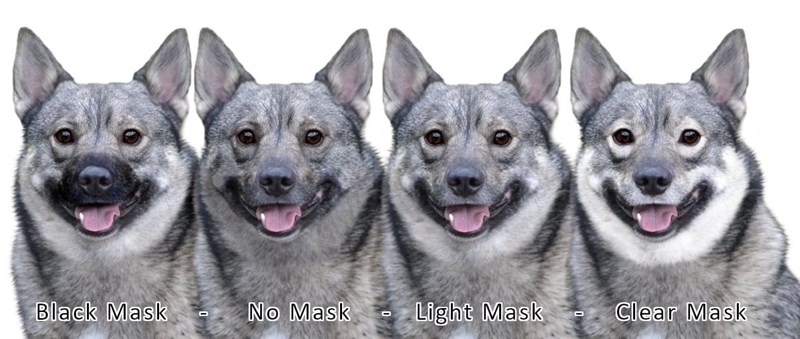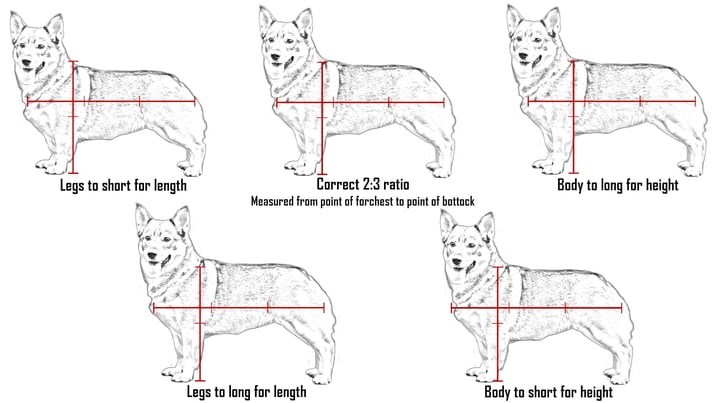Characteristics of the Breed
by Jo Day & Debbie Howe
The Swedish Vallhund is quite an unusual breed in that it is one of the few breeds that carries the natural bob tail gene, which is why so many tail types exist and all of them are considered perfectly acceptable! The varieties you may see include:
- No tail at all (not even a little stump)
- Natural stump of any length
- All variations from the stump to a full-length spitz-type’ tail
These stumps and tails can be carried in any position, with full tails sometimes carried in a tight curl to a looser waving flag - and everything in between! Some dogs will hold them down when relaxed, or on the table at a show and then will bring them up again, often with a degree of curl, when on the move. The important point to remember with tails is that they are all correct provided they are ‘set on’ (positioned) to merge with the desired slightly sloping croup. There is NO right or wrong when it comes to a Swedish Vallhund’s tail or lack of one! (see boxout)
Coat colour
Don’t you just love a Swedish Vallhund? They come with a variety of tails AND in so many different colours! The UK Kennel Club Breed Standard states the following colours are currently used for registration but some of them may not appear in the breed standard.
- Grey
- Grey and white
- Grey brown
- Grey sable
- Grey sable and white
- Greyish yellow
- Red
- Red sable
- Reddish brown
- Reddish yellow
- Sable
- Steel grey
- Wolf grey
- Colour not recognised.
Not forgetting, of course, up to a third of the dog’s colour can be white - quite a significant amount of the dog! Historically, we often had dogs being shown with a white chest, paws or leg markings. Some would have a full or half white collar. Some even had a blaze and all were permitted and within the breed standard. Although rarely seen
today, they can and do pop up in the ring and should not be penalised.
So, as a judge or an admirer of the breed, you may be standing in the centre of the ring - or even ringside - looking at a Vallhund who in ‘type’ ticks all your boxes, but isn’t a bog standard mid grey, then you may think ‘Well, grey comes in plenty of shades from very light through to very dark…’ (fifty shades allegedly!).
The red coats can also come in every shade from a slight orangey/red tinge to a dark red sable. The chances of seeing a Vallhund of an unacceptable colour in the ring is very, very slight.
Mask and harness markings
Just to throw in a curve ball to a breed whose tail comes as ‘anything goes’ and its coat colour can be from the lightest pale grey or greyish yellow through to a very dark wolf grey or steel grey (think of the huge varieties in wolf colours), add in mask and harness markings, which within our standard states:
Mask and harness
markings
- Although a dark mask is acceptable, a well defined mask is highly desirable with lighter hair around eyes, on muzzle and under the throat, giving a distinct contrast to the upper mask.
- Harness markings should be clearly defined
So where does that leave you?
You have decided you are happy with the conformation, the movement, the character and the breed type. You have recalled the fact that anything is acceptable in the tail (or lack of) and the dog you’re looking at is an acceptable colour (aforementioned wide range of acceptable colours). The dog has the desired harness markings coming across its chest and down the shoulders, but it doesn’t have a clearly defined mask... Then you remember the standard says a dark mask is acceptable although a well-defined mask is highly desirable. You glance again around the ring and your mind is made up! You are happy your chosen line up fits the bill in your interpretation of the standard as you read it.
That’s all we ask for - someone who is aware of the wide range of acceptable colours, the complete lack of tail a stump of any length or a full tail of any carriage, that you understand our breed standard and yes, we do work towards the clear well defined mask, but there are some Vallhunds who have a darker mask but still fit the standard aside from that.
The variety in tails, coat colours and markings are just 3 of the things which goes towards making up the Swedish vallhund. We hope this article has made them a little clearer and please if in doubt ask, we are always happy to talk Vallhunds with people.




Diagrams by Joanne Stockbridge